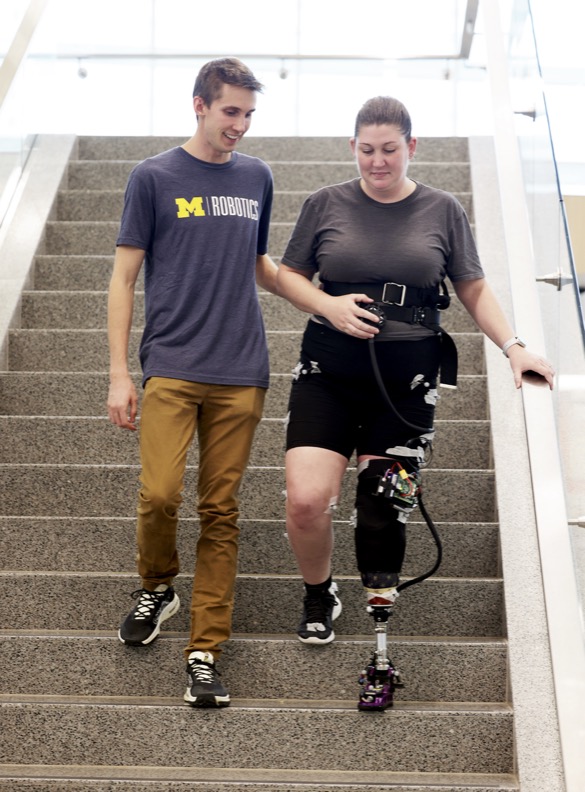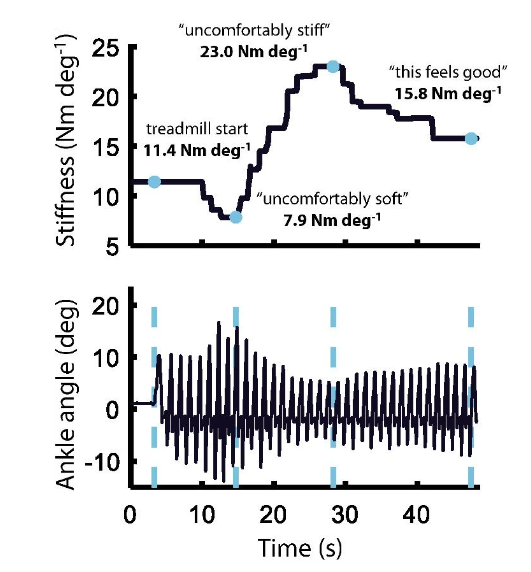Prosthetic Ankle Stiffness Perception
Motivation
The human ankle is able to continuously vary its biomechanical properties to accommodate different locomotion activities and the changing needs of the individual. However, most commercial prostheses are static, foot-shaped springs that are generally suitable for standing and level ground walking, but may not be optimal for other activities, such as traversing stairs or ramps. The Variable Stiffness Prosthetic Ankle Foot (VSPA Foot), developed by the Neurobionics Lab, is a first-of-its-kind prosthetic foot that allows the user to adjust the ankle stiffness in real time. Utilizing the VSPA Foot, we are exploring the effects of stiffness without requiring users to don and doff multiple prostheses
Approach
Our ongoing efforts with the VSPA Foot are centered on user perception of prosthetic ankle stiffness and the accompanying biomechanics. First and foremost, we are focused on the idea of user-preferred ankle stiffness, which we believe can serve as a ‘meta-criterion’ for stiffness selection, capturing the many factors that are important to prosthesis users. In particular, we are quantifying the variation in preferred stiffness across locomotion activities, including level walking, incline/decline ramp walking, and stair ascent/descent. In these experiments, we allow people with amputation to continuously adjust their own prosthetic ankle stiffness as they ambulate, until they reach a stiffness that they ‘prefer’ (see video to right). We are also investigating the biomechanical factors that may drive user-preferred stiffness, and whether these factors vary across activities. To do so, we ask participants to walk at a variety of ankle stiffness settings at and around their preferred stiffness, and analyze the changes in kinetics and kinematics.
Another area of research we are exploring is just-noticeable difference (JND), which is the minimum a stimulus must change in order to be detectable to the user. In this work, the researcher remotely sets the VSPA Foot’s stiffness and the participant is asked whether they think the current stiffness is higher or lower than the previous stiffness. By repeating these comparisons, we can establish the minimal detectable change in ankle stiffness. We are currently using this protocol to determine whether users are more perceptive of stiffness changes in some tasks than others.
In our past work, we established user-preferred stiffness and JND for level-ground walking. We found that users had consistent, repeatable preferences, and could detect stiffness changes of 7.7% of their preferred stiffness. We also compared this preferred stiffness to a stiffness chosen by prosthetists and found that the prosthetists’ chosen stiffness was, on average, 26% higher than the stiffness chosen by the user. These findings highlight the important differences between what users prefer and what prosthetists prefer. Through biomechanical analyses, we found that on level ground, users do not seem to prefer stiffness settings that minimize their metabolic cost, but may rather be picking a stiffness that increased the symmetry between their intact and prosthetic ankle motion. We believe the results of this research will inform the design and control of future prostheses, demonstrating the extent to which variable stiffness behavior is not only biomechanically favorable, but also desired by users.


Contributors: Nicholas Pett, Hannah Frame, Tyler Clites, Max Shepherd, Elliott Rouse
